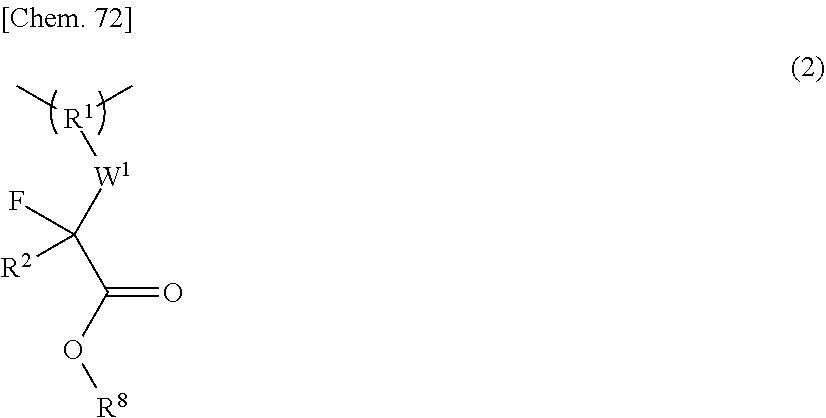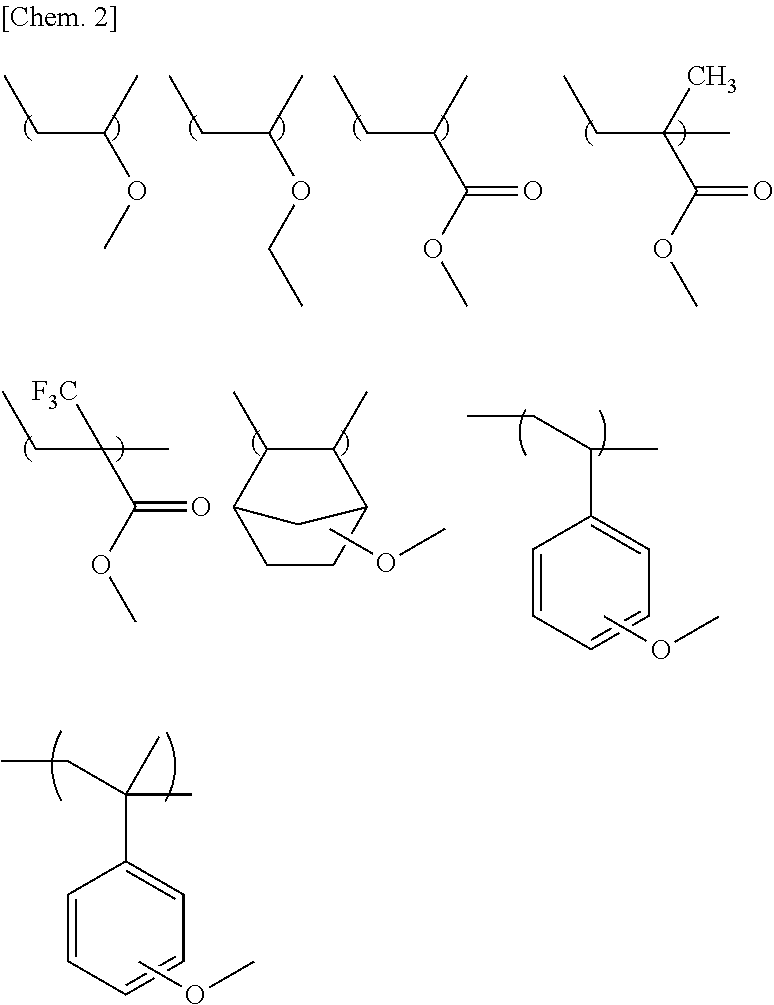Fluorine-Containing Compound, Fluorine-Containing Polymer Compound, Resist Composition, Top Coat Composition And Pattern Formation Method
a technology of polymer compound and resist, which is applied in the direction of basic electric elements, electrical equipment, and materials with high light absorption, can solve the problems of pattern collapse due to film swelling, not disclose an ester polymer, and show too high light absorption of resins to be used in the above wavelength range, etc., to achieve sufficient water repellency, and improve the water repellency of resist films
- Summary
- Abstract
- Description
- Claims
- Application Information
AI Technical Summary
Benefits of technology
Problems solved by technology
Method used
Image
Examples
synthesis example 1
Synthesis of methacrylic acid 1-chlorocarbonyl-1,1-difluoro-2-butyl ester
[0242]
[0243]Into a 3 L vessel with a dropping funnel, 420 g (purity: 56%, 1.25 mol) of methacrylic acid 1-hydroxycarbonyl-1,1-difluoro-2-butyl ester obtained by a process disclosed in Japanese Laid-Open Patent Publication No. 2009-19199 and 7.50 g (0.11 mol, 0.01 eq) of dimethylformamide were dropped. Further, 452 g (3.79 mol, 3.0 eq) of thionyl chloride was added into the vessel at room temperature. The resulting solution was heated to 75° C. and stirred for 4 hours. The completion of the reaction was confirmed by 19F NMR. The reaction-completed solution was then subjected to distillation under a reduced pressure. With this, 255 g of methacrylic acid 1-chlorocarbonyl-1,1-difluoro-2-butyl ester was obtained (yield: 92%, purity: 98%).
Properties of methacrylic acid 1-chlorocarbonyl-1,1-difluoro-2-butyl ester
[0244]1H NMR (measurement solvent: deuterated chloroform, reference material: tetramethylsilane): δ=6.14 (s...
example 1
Production of 2,2-difluoro-3-methacryloyloxycarbonyl pentanoic acid 2-exo-norbornyl ester
[0247]
[0248]Into a 1 L glass flask with a dropping funnel, 95.0 g (0.847 mol, 1.2 eq) of exo-norboneol, 510 g of diisopropyl ether, 100 g (0.988 mol, 1.4 eq) of triethylamine and 1 g of antioxidant “Nonflex MBP” (manufactured by Seiko Chemical Co., Ltd.) were added. The resulting solution was cooled to 0° C. and stirred, followed by dropping thereto 170 g (purity: 99%, 0.706 mol) of methacrylic acid 1-chlorocarbonyl-1,1-difluoro-2-butyl ester. The thus-obtained reaction solution was stirred for 1 hour at room temperature. The completion of the reaction was confirmed by 19F NMR. The reaction-completed solution was separated into an organic layer and an aqueous layer by the addition of 500 mL of water. The organic layer was dehydrated with magnesium sulfate, filtrated, and then, concentrated under a reduced pressure. The concentration residue was subjected to distillation under a reduced pressure....
example 2
Production of methacrylic acid 1-(n-butoxycarbonyl)-1,1-difluoro-2-butyl ester
[0251]
[0252]Into a 1 L glass flask with a dropping funnel, 62.8 g (0.847 mol, 1.2 eq) of n-butanol, 510 g of diisopropyl ether, 100 g (0.988 mol, 1.4 eq) of triethylamine and 1 g of antioxidant “Nonflex MBP” (manufactured by Seiko Chemical Co., Ltd.) were added. The resulting solution was cooled to 0° C. and stirred, followed by dropping thereto 170 g (purity: 99%, 0.706 mol) of methacrylic acid 1-chlorocarbonyl-1,1-difluoro-2-butyl ester. The thus-obtained reaction solution was stirred for 1 hour at room temperature. The completion of the reaction was confirmed by 19F NMR. The reaction-completed solution was separated into an organic layer and an aqueous layer by the addition of 500 mL of water. The organic layer was dehydrated with magnesium sulfate, filtrated, and then, concentrated under a reduced pressure. The concentration residue was subjected to distillation under a reduced pressure. With this, 179...
PUM
| Property | Measurement | Unit |
|---|---|---|
| wavelength | aaaaa | aaaaa |
| mass % | aaaaa | aaaaa |
| mass % | aaaaa | aaaaa |
Abstract
Description
Claims
Application Information
 Login to View More
Login to View More - R&D
- Intellectual Property
- Life Sciences
- Materials
- Tech Scout
- Unparalleled Data Quality
- Higher Quality Content
- 60% Fewer Hallucinations
Browse by: Latest US Patents, China's latest patents, Technical Efficacy Thesaurus, Application Domain, Technology Topic, Popular Technical Reports.
© 2025 PatSnap. All rights reserved.Legal|Privacy policy|Modern Slavery Act Transparency Statement|Sitemap|About US| Contact US: help@patsnap.com



